|
ChinatownBy Nina Wu with contributions by Karen Solomon and Louis Martin |
||
The
Chinese area of
town along Kearny Street and Grant takes City crawlers into an entirely
different world of sights, sounds, smells, and of course, |
||
Its heart
is the corner of corner of Kearny and Washington, and it’s difficult
to miss the multi-colored sign for the much-touted House of Nanking
(919 Kearny), 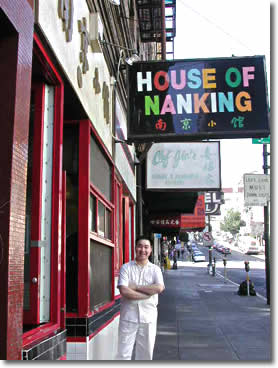 and
even harder to miss the pungent smell of stir-fry or the sizzle of the wok
as you walk past its open windows. This is a popular spot for locals and
tourists alike for good reason—the prices are low, the portions are
generous, the food is rich and delicious, and the service is kind and quick.
There isn’t much in the way of decor, but any table is a comfortable
place to park for a hearty meal. Check out the plates that come with garlic—these
are large pieces of garlic fried to a crisp so that they taste like chips.
The choices are abundant. Take note of the green onion pancakes, chicken
with Tsing-Tao beer sauce, crispy sole with garlic sauce, or the sizzling
scallops and Nanking-stuffed mushrooms. Or if you can’t decide, the
staff will be happy to just start bringing out platters of food for the
table—though chances are good that the food will keep coming long
after you’ve had your fill. Get there early to avoid the long lines,
particularly on weekends. and
even harder to miss the pungent smell of stir-fry or the sizzle of the wok
as you walk past its open windows. This is a popular spot for locals and
tourists alike for good reason—the prices are low, the portions are
generous, the food is rich and delicious, and the service is kind and quick.
There isn’t much in the way of decor, but any table is a comfortable
place to park for a hearty meal. Check out the plates that come with garlic—these
are large pieces of garlic fried to a crisp so that they taste like chips.
The choices are abundant. Take note of the green onion pancakes, chicken
with Tsing-Tao beer sauce, crispy sole with garlic sauce, or the sizzling
scallops and Nanking-stuffed mushrooms. Or if you can’t decide, the
staff will be happy to just start bringing out platters of food for the
table—though chances are good that the food will keep coming long
after you’ve had your fill. Get there early to avoid the long lines,
particularly on weekends. |
||
| The numerous alleyways in which to explore and wander house discoveries for the open-minded eater. Chinatown offers plenty of inexpensive, but good, places to eat dim sum that are often open seven days a week. Most don’t have "atmosphere" or much in the way of Western-style service, but they’re reminiscent of the little eating holes on the street corners of Hong Kong. Service might not be what you’re used to, as the Cantonese mentality is practical. The idea isn’t to pamper you with niceties or provide ambience. Why waste time with all that? The idea is to serve good food, efficiently. So if service may at first seem rude, don’t take it personally. Take note of the speed with which your waiter smacks down that bowl of won tons before you. | ||
The Pot
Sticker (150 Waverly Place) is one of those alleyway haunts,
and they |
||
|
Note: Sam
Wo restaurant, described below, is now closed. But it is a piece of
restaurant history in San Francisco, so its story is being retained here. It
opened in 1912 and closed, by order of the San Francisco Health Department,
in 2012. The then owners could not afford to fix the problems and seemed to
lack the will to do so. Its status is still somewhat in limbo with the
owners looking for a new locations, or so they say. Additional notes: (1)
The editor of CoastNews.com once observed a cook come out of the
tiny restroom that contains no wash basin and wipe his hands on an extremely
dirty apron. (2) A customer who ate at Sam Wo in the days of
Edsel Wong reported that Wong went so far as to snap women's bras from
the rear. He is not a "modern character" but a part, nevertheless, of San
Francisco history. — Louis
Martin Sam Wo (813 Washington) is another literary lesson. The place was made famous by legendary San Francisco writer Herb Caen for its famously rude waiter, 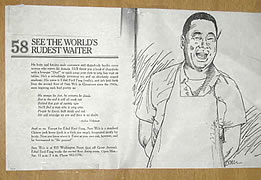 Edsel
Wong. The restaurant has been around for 100 years for good reason—it’s
a hole-in-the-wall, but it has a simple, rustic charm. Enter and you’ll
practically smack into a kitchen where the cooks are sweating and multi-tasking
on the ground floor. Climb up the tiny, metal stairway to the right and
you’ll find a few tables with cracking, orange paint, along with wooden
stools that make you feel as if you’re in an elementary school classroom.
Hanging above each table are what look like pages taken from a calendar—photos
of orange goldfish taped to the wall. Don’t stop here. Up one Edsel
Wong. The restaurant has been around for 100 years for good reason—it’s
a hole-in-the-wall, but it has a simple, rustic charm. Enter and you’ll
practically smack into a kitchen where the cooks are sweating and multi-tasking
on the ground floor. Climb up the tiny, metal stairway to the right and
you’ll find a few tables with cracking, orange paint, along with wooden
stools that make you feel as if you’re in an elementary school classroom.
Hanging above each table are what look like pages taken from a calendar—photos
of orange goldfish taped to the wall. Don’t stop here. Up one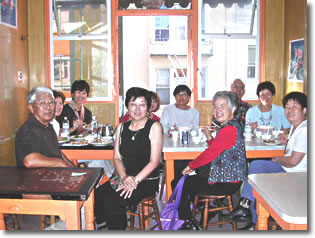 more flight is the table by the fire escape, and it’s the best in
the house, overlooking the bustle of Washington Street. Help yourself to
a pair of disposable, wooden chopsticks. Tea is on the house. Though Edsel
was famously rude, the current servers (it’s a family-run place) are
very nice. They pull on a rope, using a dummy waiter, to serve dishes from
the bottom-floor kitchen to the upper two floors. The menu offers won ton
soup, rice noodle soup, thick rice soup (otherwise known as jook
in Cantonese), fried chow mein noodles, along with chow fun and rice plates.
Any of the noodle plates are a good pick, delicious and priced well. The
noodles are thick, but not sticky. They come with broccoli and beef, shrimp,
duck, chicken or mixed vegetables. Among the pick of appetizers, the barbecue
pork and rice noodle rolls are filling with chunky pieces of pork wrapped
in thick, white chow fun. They’re great, especially when accompanied
by a little bit of hot mustard.
more flight is the table by the fire escape, and it’s the best in
the house, overlooking the bustle of Washington Street. Help yourself to
a pair of disposable, wooden chopsticks. Tea is on the house. Though Edsel
was famously rude, the current servers (it’s a family-run place) are
very nice. They pull on a rope, using a dummy waiter, to serve dishes from
the bottom-floor kitchen to the upper two floors. The menu offers won ton
soup, rice noodle soup, thick rice soup (otherwise known as jook
in Cantonese), fried chow mein noodles, along with chow fun and rice plates.
Any of the noodle plates are a good pick, delicious and priced well. The
noodles are thick, but not sticky. They come with broccoli and beef, shrimp,
duck, chicken or mixed vegetables. Among the pick of appetizers, the barbecue
pork and rice noodle rolls are filling with chunky pieces of pork wrapped
in thick, white chow fun. They’re great, especially when accompanied
by a little bit of hot mustard. |
||
Hang Ah Tea Room (Padoga alley off Sacramento between Stockton and Grant) is a kind of refuge for me. It is a place of comfort, familiarity, and healthy green light. I go there as much to meditate and feel good as to eat. Nancy Cai (shown below with Combo Chow Mein with Hong Kong style fried noodles) is the owner and she works there seven days a week. She has two young daughters, Christine and Emily, and she always looks a little sleepy. She reminds me of a Snoopy cartoon character, warm, friendly, and human.
I like her because she moves slowly, always takes her time, and inspires me to do the same. But she always brings me a glass of cold white wine, filled to the brim, as soon as I come in. With that I am content. If only some of the fast-paced, trendy restaurants in San Francisco knew this trick! Hang Ah is not a three-star restaurant. In most people's book, it probably has no stars at all. It is a "slow-eating" restaurant where you can take your time and enjoy the food. It is not on the cutting edge of anything other than providing comfort and food that you would actually enjoy eating every single day of the week. Which is not to say it is dull. It is not. Like a lot of Chinese restaurants, it has so much stuff on the menu that I will probably never try everything. Nevertheless, I have tried quite a few items, such Law Bock Gow, or turnip cake.
This is one item that you would probably bypass after reading the description on the menu. But I asked Nancy about it one day and she said it was very good. I tried it. It is made from white turnips, bacon, and mushrooms, making it taste a little like a Spanish torte or a French quiche. I found it quite tasty. But it's not a dish that would win a prize downtown. It's not "competitive" food. If you are on a date, and your date is a "major foodie," don't take him or her to Hang Ah. He or she is not going to appreciate it. Take your date to one of those places where the food is the only subject of conversation, other than the wine, of course. But do take a good friend to Hang Ah. You're going to enjoy the food and the conversation. And you're always going to be discovering something new on the menu. You might, if you're lucky, develop an appreciation for Chinese food and time-tested dishes that are so tasty they don't need to be messed with that much. They just need to be made well, as they are at Hang Ah. There are other places in Chinatown like this. Hunan's Home may not blow you away the first time you eat there unless, perhaps, you order one of the sizzling plates, say of prawns or chicken. Same for Great Eastern Restaurant, though it is a bit on the fancier side with waiters dressed in tuxedos. And some of the dishes, like the soups, are so stylish they might even win a prize. You might even consider taking your date there. He or she would at least find it ma ma hu hu (so-so). But of course none of these places is going to get any stars when it comes around to review time. These may be great places to eat, great places to talk, great places to meet a friend regularly, and great places to hang out, chill out, and any other good kind of hang you can think of, but the reviewers could care less about that. If I have learned one thing about Chinese food it is this: If it is good, it always has good flavor. They don't create flavors to annoy you are tease you. They make whatever it is taste good so you feel like putting it in your mouth and eating it, such as Hang Ah's crispy shrimp balls shown below. And it always has variety and balance. These qualities are not always highly evident in French or Italian food, where one dish tends to lead to the next in an unending quest to satisfy the pallet, the last attempt being the desert, and if that doesn't do it, coffee and an after dinner drink. Good Chinese food does not require this. The courses, once they start coming, arrive in rapid succession, and one does not switch to the chow mein because the sizzling prawns just don't satisfy a demanding pallet. One switches to the chow mein because one feels like it. That is before the eye notices the sweet bowl of vegetables or the Crispy Shrimp Balls (show below), and then the ... Desert? Who needs it. Maybe a slice of orange, a little cookie but no elaborate concoction of chocolate, cream ...
So maybe between your visits to all those star-studded restaurants, you might consider a humble little meal at some place where there are a few free table, the price won't burn a whole in your pocket, and you can cary on a conversation while eating flavorful healthy food. You will receive fair value for your money and feel good about it all day. While San Francisco Restaurant & Dining Guide does not award stars to restaurants, if it did, Hang Ah would surely get three stars for everything that really matters. (Hang Ah Tea Room by Louis Martin.) |
||
Tourists
seem to flock to Brandy Ho’s Hunan Food (217 Columbus).
Perhaps it’s 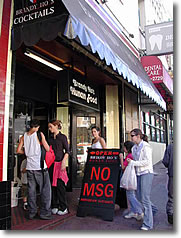 the
proximity to North Beach, or it could be the sleek bar, the entertaining
open kitchen, or its fine selection of sweet and sour dumplings or spicy
beef with green onions in wine sauce. Or maybe its the hearty soups, like
the egg-pork-tofu-vegetable soup that'll warm your insides on a cold day
like a shot of brandy. But one cautionary note: When they say hot, they
mean hot. For most palletes, it is probably best to order the milder versions
of dishes. It also has another entrance on Pacific. That is the Chinatown
enterance. The entrance on Columbus is the North Beach entrance. Unlike
the sparse and terse hole-in-the-wall places, this has ambience. It seems
somewhat strange these days, but a sign outside advertises “NO MSG”.
An even larger sign inside says "ASOLUTELY NO MSG." Some kind
of joke, perhaps? The cooking is based on the peasant style of the Hunan
region, located in China’s countryside. Hunan dishes are hot and spicy,
with lots of garlic. Meats are house-smoked on premises, using hardwood
to bring out a distinct, Hunan flavor. Brandy Ho’s is named after
three native Hong Kong brothers—Chef Sedgwick Ho, Jack Ho, and Brandy
Ho, the restaurant’s namesake. the
proximity to North Beach, or it could be the sleek bar, the entertaining
open kitchen, or its fine selection of sweet and sour dumplings or spicy
beef with green onions in wine sauce. Or maybe its the hearty soups, like
the egg-pork-tofu-vegetable soup that'll warm your insides on a cold day
like a shot of brandy. But one cautionary note: When they say hot, they
mean hot. For most palletes, it is probably best to order the milder versions
of dishes. It also has another entrance on Pacific. That is the Chinatown
enterance. The entrance on Columbus is the North Beach entrance. Unlike
the sparse and terse hole-in-the-wall places, this has ambience. It seems
somewhat strange these days, but a sign outside advertises “NO MSG”.
An even larger sign inside says "ASOLUTELY NO MSG." Some kind
of joke, perhaps? The cooking is based on the peasant style of the Hunan
region, located in China’s countryside. Hunan dishes are hot and spicy,
with lots of garlic. Meats are house-smoked on premises, using hardwood
to bring out a distinct, Hunan flavor. Brandy Ho’s is named after
three native Hong Kong brothers—Chef Sedgwick Ho, Jack Ho, and Brandy
Ho, the restaurant’s namesake. |
||
If you
need a between-meal break, Grant Street, Chinatown’s most popular
tourist stretch, has plenty of diversions, including shops hawking souvenirs,
three T-shirts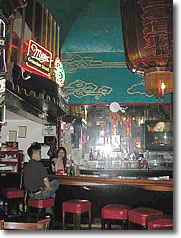 for $10, inexpensive slippers, fans, children’s toys, and all kinds
of bric-a-brac in-between. In fact, at this point in your journey, a visit
to Li Po Cocktail Lounge (916 Grant) for an afternoon cocktail
is in order. It’s named after the Chinese philosopher and poet who
once uttered many a wise saying, and it is now owned by Taiwanese-born Kenneth
Lee. A luminous ceiling painted in turquoise clouds over a giant, red lantern
provides room for imagination as one sips a mixed concoction. Manager Jack
Seto, an older fellow who’s been at the lounge for many years, says
the best drink to get is the special Mai Tai, which includes rum along with
a Chinese liqueur called Mui Kwe Lu, imported from Hong Kong. Open daily
at 2 p.m., it doesn’t get crowded until nightfall.
for $10, inexpensive slippers, fans, children’s toys, and all kinds
of bric-a-brac in-between. In fact, at this point in your journey, a visit
to Li Po Cocktail Lounge (916 Grant) for an afternoon cocktail
is in order. It’s named after the Chinese philosopher and poet who
once uttered many a wise saying, and it is now owned by Taiwanese-born Kenneth
Lee. A luminous ceiling painted in turquoise clouds over a giant, red lantern
provides room for imagination as one sips a mixed concoction. Manager Jack
Seto, an older fellow who’s been at the lounge for many years, says
the best drink to get is the special Mai Tai, which includes rum along with
a Chinese liqueur called Mui Kwe Lu, imported from Hong Kong. Open daily
at 2 p.m., it doesn’t get crowded until nightfall. |
||
Time for
a little snack to wash down that Mai Tai, don’t you think? Luckily
for us, dim sum abounds along Grant Street, and it’s an indecisive
eater’s dream. Waiters 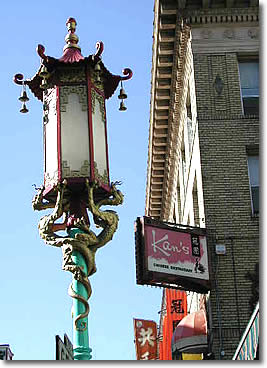 and
waitresses push carts full of appetizing delights and unveil small plates
of shrimp dumplings (known as ha gow), pork buns (called shumai), and sweet
custard egg tarts while you sit, sipping Jasmine tea. You may be wary of
the sight of duck’s feet, but you don’t have to order it. For
the most satisfying meal, go in a group of three or more and share lots
of tiny dishes. Kan’s Restaurant (708 Grant) is a
longtime establishment that offers dim sum and a regular lunch and dinner
menu in a spacious upstairs dining room. Far East Cafe Seafood Cuisine
(631 Grant) has an elegant setting ideal for accommodating large groups.
If you’re looking to dine with a large party, also try New
Asia (772 Pacific) and Meriwa Restaurant (728
Pacific). Both have dance floors large enough to accommodate large wedding
parties. New Asia is an entertainment venue as much as it is a restaurant,
with two floors, a surround-sound karaoke system, and table seating for
up to 1,000. They often host events, including Ballroom and Latin dance
classes, comedy nights, and numerous private parties. and
waitresses push carts full of appetizing delights and unveil small plates
of shrimp dumplings (known as ha gow), pork buns (called shumai), and sweet
custard egg tarts while you sit, sipping Jasmine tea. You may be wary of
the sight of duck’s feet, but you don’t have to order it. For
the most satisfying meal, go in a group of three or more and share lots
of tiny dishes. Kan’s Restaurant (708 Grant) is a
longtime establishment that offers dim sum and a regular lunch and dinner
menu in a spacious upstairs dining room. Far East Cafe Seafood Cuisine
(631 Grant) has an elegant setting ideal for accommodating large groups.
If you’re looking to dine with a large party, also try New
Asia (772 Pacific) and Meriwa Restaurant (728
Pacific). Both have dance floors large enough to accommodate large wedding
parties. New Asia is an entertainment venue as much as it is a restaurant,
with two floors, a surround-sound karaoke system, and table seating for
up to 1,000. They often host events, including Ballroom and Latin dance
classes, comedy nights, and numerous private parties. |
||
For a more
serene setting, visit Lichee Garden (1416 Powell) tucked
a couple of blocks away. This is a white tablecloth restaurant adorned with
tea green napkins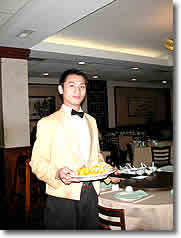 and unique, hand-painted wood panels that depict the lichee fruit (a round,
red, spiky fruit that grows in clusters). This place has ambience and courteous
service; if you want to impress your aunt from out of town, this is the
place to take her. The dining room attracts elderly grandmothers in for
a lively chat, and families enjoying a full-course meal; but it is nevertheless
a place of tranquility. Chef Chak Siu (below left) chose the fruit as his
restaurant’s namesake because they grow abundantly in his hometown
in the southern part of China. They are featured prominently on the dessert
menu,
and unique, hand-painted wood panels that depict the lichee fruit (a round,
red, spiky fruit that grows in clusters). This place has ambience and courteous
service; if you want to impress your aunt from out of town, this is the
place to take her. The dining room attracts elderly grandmothers in for
a lively chat, and families enjoying a full-course meal; but it is nevertheless
a place of tranquility. Chef Chak Siu (below left) chose the fruit as his
restaurant’s namesake because they grow abundantly in his hometown
in the southern part of China. They are featured prominently on the dessert
menu, 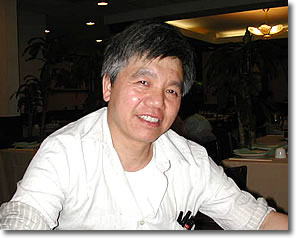 including
the deceptively simple lichee fruit on ice. Open since 1980, Lichee Garden
offers a variety of Chinese cuisines, ranging from Fu Kien-style fried rice
to shrimp with pine nuts (a California touch). Noodles are as diverse as
Japanese udon, curried Singapore style, or spicy Szechwan threads. There
is also comfort food such as egg foo young, honey walnut prawns, and Lichee’s
special wor won ton soup. Families can order multi-course dinners either
Mandarin-style, Cantonese-style, or follow the Chef’s recommendation.
Chef Siu points out that dishes of note include his tofu with black bean
sauce and Peking Duck. including
the deceptively simple lichee fruit on ice. Open since 1980, Lichee Garden
offers a variety of Chinese cuisines, ranging from Fu Kien-style fried rice
to shrimp with pine nuts (a California touch). Noodles are as diverse as
Japanese udon, curried Singapore style, or spicy Szechwan threads. There
is also comfort food such as egg foo young, honey walnut prawns, and Lichee’s
special wor won ton soup. Families can order multi-course dinners either
Mandarin-style, Cantonese-style, or follow the Chef’s recommendation.
Chef Siu points out that dishes of note include his tofu with black bean
sauce and Peking Duck. |
||
If you're
enjoying the tranquil relaxation of Lichee Garden, you would also like Louie’s
California Chinese Cuisine (646 Washington), owned by chef Guo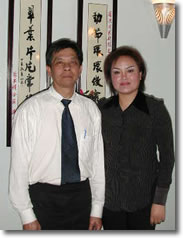 Sheng Lei (a.k.a. “Louie”). They offer an aquarium where you
can select your fish, and private dining rooms nestled behind Japanese folding
screens. Louie (right, with customer Jing Ming Liu) comes from a small town
near Kowloon, and he worked for a number of years in Hong Kong before coming
to San Francisco. Louie’s offers Chinese cuisine from a variety of
regions—Cantonese, Szechwan and dim sum. “California”
in the restaurant’s name refers to Louie’s use of California-grown
vegetables (yes, he even buys organic when possible), and he offers a list
of California wines. Signature dishes are the steamed or stir-fried sturgeon,
curried crab, or anything made with abalone—the chef’s favorite
ingredient. Louie’s younger brother is also a chef in China.
Sheng Lei (a.k.a. “Louie”). They offer an aquarium where you
can select your fish, and private dining rooms nestled behind Japanese folding
screens. Louie (right, with customer Jing Ming Liu) comes from a small town
near Kowloon, and he worked for a number of years in Hong Kong before coming
to San Francisco. Louie’s offers Chinese cuisine from a variety of
regions—Cantonese, Szechwan and dim sum. “California”
in the restaurant’s name refers to Louie’s use of California-grown
vegetables (yes, he even buys organic when possible), and he offers a list
of California wines. Signature dishes are the steamed or stir-fried sturgeon,
curried crab, or anything made with abalone—the chef’s favorite
ingredient. Louie’s younger brother is also a chef in China. |
||
The R&G
Lounge (631 Kearny) is an immaculate, three-story restaurant with
reasonable prices. Owner Kinson K. Wong opened the place in 1985 after 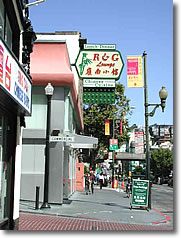 spending
a decade as a dim sum chef in San Francisco and Hong Kong. He bought the
ground floor and remodeled it, and then later bought the rest of the building.
Wong has turned the place into a pleasant venue, with a bar on the ground
floor. Upstairs, the dining rooms features Japanese bamboo screens, antiques,
and some contemporary touches, like a goldfish aquarium hanging in a jug
next to the stairs. Wong says keeping the restaurant clean is a high priority,
along with good service. The name was inspired by a Chinese university’s
motto meaning “Red & Great”, but nowadays, Wong just likes
to say that it stands for “Real Good.” The signature dish is
the live battered crab, deep-fried and sprinkled with salt and pepper. spending
a decade as a dim sum chef in San Francisco and Hong Kong. He bought the
ground floor and remodeled it, and then later bought the rest of the building.
Wong has turned the place into a pleasant venue, with a bar on the ground
floor. Upstairs, the dining rooms features Japanese bamboo screens, antiques,
and some contemporary touches, like a goldfish aquarium hanging in a jug
next to the stairs. Wong says keeping the restaurant clean is a high priority,
along with good service. The name was inspired by a Chinese university’s
motto meaning “Red & Great”, but nowadays, Wong just likes
to say that it stands for “Real Good.” The signature dish is
the live battered crab, deep-fried and sprinkled with salt and pepper. |
||
Now if you have eaten your way around Chinatown and feel like you've had enough Chinese food for awhile, you can find a Sushi spot on Grant, corner of Sacramento, I think. (Can't even remember her name.) But it's mostly a place to go and watch tourists. You won't see many Chinese diners there, and that is the real test of good Chinese food: a long line of Chinese people waiting out front to get in. That is what the late Jing Ming Liu, one very picky Chinese diner, used to say, and I believe it completely. So
let's just say you want a change of pace. Well even the Chinese like a
little change of pace from their own food at times. Too much of a good
thing can become tiresome, so every now and then they venture out and
and try something new. So if that is the case with you, you might want
to try Penang Garden, a new Thai-Malaysia-Singapore restaurant
on Washington (728). It's the only such place in Chinatown, says Steven
Ouyang, general manager. No arguments there. The (Penang Garden by Louis Martin.) |
||
But don’t
just take our word on his restaurant, or any other that we’ve described
in this section. The definitive authority on all that is Chinatown is surely
Shirley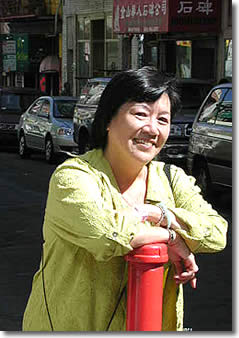 Fong-Torres, better known as Shirley Wok-Wiz, who gives culinary
and historical walking tours every morning, as well as occasional themed
walks, such as the: “I Can’t Believe I Ate My Way Through Chinatown!”
tour. Follow Shirley, who is an educator, historian, cookbook author, TV
chef, and entertainer all wrapped into one, and she’ll give you more
than the tourist’s-eye view of the town. She’ll share the culture
and ingredients of Chinese cuisine. She’ll also share her own history
of living in the area, such as how her father arrived in San Francisco via
the Philippines when the 1882 Chinese Exclusion Act was still in place.
He called himself Torres, and he worked as a busboy at the Fairmont Hotel
before working his way to a cook and eventually a chef. “I’m
very serious about our culinary history and people,” she says. “I
like to intertwine all of that.” The tours starts on Commercial, then
moves to Portsmouth Square (Chinatown’s unofficial living room) and
beyond. Group evening tours are also available, complete with a Chinese
banquet dinner and cooking shows. Reservations can be made at www.wokwiz.com.
Fong-Torres, better known as Shirley Wok-Wiz, who gives culinary
and historical walking tours every morning, as well as occasional themed
walks, such as the: “I Can’t Believe I Ate My Way Through Chinatown!”
tour. Follow Shirley, who is an educator, historian, cookbook author, TV
chef, and entertainer all wrapped into one, and she’ll give you more
than the tourist’s-eye view of the town. She’ll share the culture
and ingredients of Chinese cuisine. She’ll also share her own history
of living in the area, such as how her father arrived in San Francisco via
the Philippines when the 1882 Chinese Exclusion Act was still in place.
He called himself Torres, and he worked as a busboy at the Fairmont Hotel
before working his way to a cook and eventually a chef. “I’m
very serious about our culinary history and people,” she says. “I
like to intertwine all of that.” The tours starts on Commercial, then
moves to Portsmouth Square (Chinatown’s unofficial living room) and
beyond. Group evening tours are also available, complete with a Chinese
banquet dinner and cooking shows. Reservations can be made at www.wokwiz.com.
Note: The above tribute—what else can you call it?—to Shirley Fong-Torres was written by Nina Wu a few years back. Since then, the legendary Chinatown guide to cultural history and food has passed on to another world (2011), where she is no doubt giving enlightened tours to the surprise and delight of all who have made it there and not to the other place. Her brother, writer Ben Fong-Torres lives on in this world as well as her daughter, Tina. Positive note: Tina is now carrying on the good work at www.wokwiz.com, where tours can still be arranged. Salud!—or perhaps we had better say 健康!—to the Fong-Torres family! — Louis Martin |
The
Time of Your Life in San Francisco